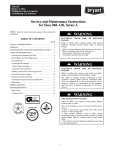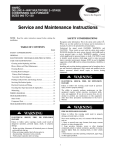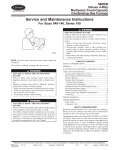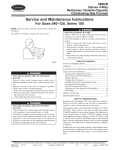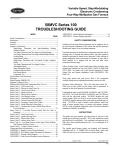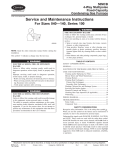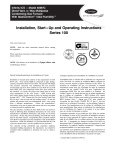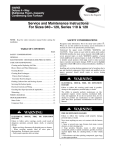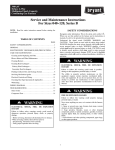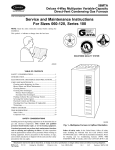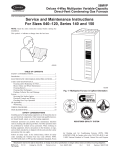Download Carrier INFINITY ICS 58MVC Instruction manual
Transcript
Infinity ICS --- Model 58MVC, Direct Vent 4---Way Multipoise Condensing Gas Furnace With IdealComfortt IdealHumidityt Service and Maintenance Procedures NOTE: Read the entire instruction manual before starting the installation. ! ama WARNING CERTIFIED ISO 9001:2000 ELECTRICAL SHOCK, FIRE OR EXPLOSION HAZARD REGISTERED Failure to follow warnings could result in personal injury, death, or property damage. As an ENERGY STAR® Partner, Carrier Corporation has determined that this product meets the ENERGY STAR® guidelines for energy efficiency. Improper servicing could result in dangerous operation, serious injury, death, or property damage. --Before servicing, disconnect all electrical power to furnace. SAFETY CONSIDERATIONS --When servicing controls, label all wires prior to disconnecting. Reconnect wires correctly. Recognize safety information. This is the safety--alert symbol . When you see this symbol on the unit and in instructions or manuals, be alert to the potential for personal injury. Understand the signal words DANGER, WARNING, CAUTION, and NOTE. These words are used with the safety--alert symbol. DANGER identifies the most serious hazards which will result in severe personal injury or death. WARNING signifies hazards which could result in personal injury or death. CAUTION is used to identify unsafe practices which may result in minor personal injury or product and property damage. NOTE is used to highlight suggestions which will result in enhanced installation, reliability, or operation. Untrained personnel can perform basic maintenance functions described in User’s Information Manual such as cleaning and replacing air filters. All other operations must be performed by trained service personnel. When working on heating equipment, observe precautions in the literature, on tags, and on labels attached to or shipped with the unit and other safety precautions that may apply. --Verify proper operation after servicing. ! WARNING ELECTRICAL SHOCK, FIRE OR EXPLOSION HAZARD Failure to follow this warning could result in property damage, personal injury, or death. The ability to properly perform maintenance on this equipment requires certain expertise, mechanical skills, tools, and equipment. If you do not possess these, do not attempt to perform any maintenance on this equipment other than those procedures recommended in the User’s Manual. ! WARNING ! CAUTION FIRE OR EXPLOSION HAZARD CUT HAZARD Failure to follow this warning could result in personal injury, death, or property damage. Failure to follow this caution may result in personal injury. Be careful of sharp metal edges, etc. Use care and wear protective clothing, gloves, and safety glasses when removing parts. Installing and servicing heating equipment can be hazardous due to gas and electrical components. Only trained and qualified service agency personnel should install, repair, or service heating equipment. Follow all safety codes including the National Fuel Gas Code (NFGC) NFPA 54--2006/ANSI Z223.1--2006 in the USA, CSA B149.1--05 National Standard of Canada, Natural Gas and Propane Installation Codes (NSCNGPIC) in Canada, and the Installation Standards, Warm Air Heating and Air Conditioning Systems (NFPA 90B) ANSI/NFPA 90B. Wear safety glasses and work gloves. Have a fire extinguisher available during start--up and adjustment procedures and service calls. Never store anything on, near, or in contact with the furnace, such as: 1. Spray or aerosol cans, rags, brooms, dust mops, vacuum cleaners, or other cleaning tools. 2. Soap powders, bleaches, waxes or other cleaning compounds, plastic or plastic containers, gasoline, kerosene, cigarette lighter fluid, dry cleaning fluids, or other volatile fluids. 3. Paint thinners and other painting compounds, paper bags, or other paper products. 1 ELECTROSTATIC DISCHARGE (ESD) PRECAUTIONS ! CAUTION UNIT DAMAGE HAZARD Failure to follow this caution may damage furnace components. 58MVC Failure to follow this caution may damage furnace components. Electrostatic discharge can affect electronic components. Take precautions during furnace installation and servicing to protect the furnace electronic control. Precautions will prevent electrostatic discharges from personnel and hand tools which are held during the procedure. These precautions will help to avoid exposing the control to electrostatic discharge by putting the furnace, the control, and the person at the same electrostatic potential. 1. Disconnect all power to the furnace. DO NOT TOUCH THE CONTROL OR ANY WIRE CONNECTED TO THE CONTROL PRIOR TO DISCHARGING YOUR BODY’S ELECTROSTATIC CHARGE TO GROUND. 2. Firmly touch a clean, unpainted, metal surface of the furnace chassis which is close to the control. Tools held in a person’s hand during grounding will be satisfactorily discharged. 3. After touching the chassis, you may proceed to service the control or connecting wires as long as you do nothing that recharges your body with static electricity (for example; DO NOT move or shuffle your feet, DO NOT touch ungrounded objects, etc.). 4. If you touch ungrounded objects (recharge your body with static electricity), firmly touch furnace again before touching control or wires. 5. Use this procedure for installed and uninstalled (ungrounded) furnaces. 6. Before removing a new control from its container, discharge your body’s electrostatic charge to ground to protect the control from damage. If the control is to be installed in a furnace, follow items 1 through 5 before bringing the control or yourself into contact with the furnace. Put all used AND new controls into containers before touching ungrounded objects. 7. An ESD service kit (available from commercial sources) may also be used to prevent ESD damage. A05085 Fig. 1 -- Multipoise Furnace in Upflow Orientation GENERAL This furnace can be installed as a direct vent (2--pipe) or an optional ventilated combustion air condensing gas furnace. These instructions are written as if the furnace is installed in an upflow application. An upflow furnace application is where the blower is located below the combustion and controls section of the furnace, and conditioned air is discharged upward. Since this furnace can be installed in any of the 4 positions shown in Fig. 2, you may need to revise your orientation to component location accordingly. AIRFLOW CARE AND MAINTENANCE UPFLOW For continuing high performance and to minimize possible furnace failure, it is essential that maintenance be performed annually. Consult your local dealer for maintenance and maintenance contract availability. HORIZONTAL LEFT HORIZONTAL RIGHT ! DOWNFLOW AIRFLOW AIRFLOW WARNING ELECTRICAL SHOCK HAZARD Failure to follow this warning could result in personal injury or death. AIRFLOW Turn off the gas and electrical supplies to the unit before performing any maintenance or service. Follow the operating instructions on the label attached to the furnace. A93041 Fig. 2 -- Multipoise Orientation 2 WASHABLE FILTER IN FURNACE FILTER RETAINER WASHABLE FILTER FILTER SUPPORT WASHABLE FILTER OR DISPOSABLE MEDIA FILTER IN FILTER CABINET WASHABLE FILTER OR DISPOSABLE MEDIA FILTER IN FILTER CABINET A00232 A00233 Fig. 3 -- Bottom Filter Arrangement Fig. 4 -- Filter Installed for Side Inlet The minimum maintenance that should be performed on this equipment is as follows: 1. Check and clean or replace air filter each month as needed. 2. Check blower motor and wheel for cleanliness annually. 3. Check electrical connections for tightness and controls for proper operation each heating season. Service as necessary. 4. Check for proper condensate drainage. Clean as necessary. 5. Check for blockages in combustion--air and vent pipes annually. 6. Check burners for cleanliness annually. A. CLEANING AND/OR REPLACING AIR FILTER The air filter arrangement may vary depending on the application or orientation. 6. Slide filter into cabinet. 7. Replace filter cabinet door. 8. Turn on electrical supply to furnace. If filter is installed in furnace blower compartment: 1. Turn off electrical supply to furnace. 2. Remove main furnace door and blower access panel. 3. Release filter retainer wire. (See Fig. 3 or 4.) NOTE: Filters shown in Fig. 3 and 4 can be in furnace blower compartment or in filter cabinet, but not in both. 4. Slide filter out of furnace. 5. Furnaces are equipped with permanent, washable filter(s). Clean filter by spraying cold tap water through filter in opposite direction of airflow. 6. Rinse filter and let dry. Oiling or coating filter is not recommended. 7. Slide filter into furnace. 8. Recapture filter retaining wire. 9. Replace blower access panel and main furnace door. 10. Turn on electrical supply to furnace. B. BLOWER MOTOR AND WHEEL MAINTENANCE To ensure long life, economy, and high efficiency, clean accumulated dirt and grease from blower wheel and motor annually. The inducer and blower motors are pre--lubricated and require no additional lubrication. These motors can be identified by the absence of oil ports on each end of the motor. The following items should be performed by a qualified service technician. ! WARNING CARBON MONOXIDE POISONING HAZARD Failure to follow this warning could result in personal injury or death. Never operate unit without a filter or with the blower access panel removed. Operating a unit without a filter or with the blower access door removed could cause damage to the furnace blower motor. Dust and lint on internal parts of furnace can cause a loss of efficiency. NOTE: If the filter has an airflow direction arrow, the arrow must point toward the blower. To clean or replace filters, proceed as follows: If filter is installed in filter cabinet adjacent to furnace: 1. Turn off electrical supply to furnace. 2. Remove filter cabinet door. 3. Slide filter out of cabinet. 4. If equipped with permanent, washable filter, clean filter by spraying cold tap water through filter in opposite direction of airflow. Rinse filter and let dry. Oiling or coating of the filter is not recommended. 5. If equipped with factory specified disposable media filter, replace only with a factory specified media filter of the same size. 3 58MVC FILTER RETAINER PLUG COLLECTOR BOX DRAIN TUBE (BLUE & WHITE STRIPED) CAP COLLECTOR BOX TUBE (PINK) INDUCER HOUSING (MOLDED) DRAIN TUBE (BEHIND COLLECTOR BOX DRAIN TUBE) COLLECTOR BOX DRAIN TUBE (BLUE) COLLECTOR BOX TUBE (GREEN , ROUTES BEHIND INDUCER) 58MVC CONDENSATE TRAP FIELD- INSTALLED FACTORY- SUPPLIED DRAIN TUBE COUPLING (LEFT DRAIN OPTION) FIELD- INSTALLED FACTORY- SUPPLIED DRAIN TUBE FIELD- INSTALLED FACTORY- SUPPLIED ½ - IN. CPVC STREET ELBOWS (2) FOR LEFT DRAIN OPTION FIELD- INSTALLED FACTORY- SUPPLIED DRAIN TUBE COUPLING (LEFT DRAIN OPTION) A07274 Fig. 5 -- Factory--Shipped Upflow Tube Configuration (Shown with Blower Access Panel Removed) c. Mark blower wheel orientation and cutoff plate location to ensure proper reassembly. d. Remove screws securing cutoff plate and remove cutoff plate from housing. e. Remove bolts holding motor mounts to blower housing and slide motor and mounts out of housing. f. Remove blower wheel from housing. g. Clean wheel per instructions on degreaser cleaner. Do not get degreaser in motor. 9. Reassemble motor and blower wheel by reversing items 8b through 8f. Ensure wheel is positioned for proper rotation. NOTE: Be sure to attach ground wire and reconnect blower harness plugs to blower motor. 10. Reinstall blower assembly in furnace. 11. Reinstall condensate trap and tubing if previously removed. a. Reinstall condensate trap in hole in blower shelf. b. Connect condensate trap drain tubes. See Fig. 5 or tubing diagram on main furnace door for proper tube location. (1.) Connect 1 tube (blue or blue and white striped) from collector box. (2.) Connect 1 tube (violet or unmarked) from inducer housing. (3.) Connect one tube (relief port, green or pink) from collector box. c. Connect field drain to condensate trap. NOTE: Ensure tubes are not kinked or pinched, as this will affect operation. 12. Reinstall control box, transformer, and door switch assembly on blower shelf. 13. Reconnect wires. a. Refer to furnace wiring diagram and connect thermostat leads if previously disconnected. (See Fig. 21.) Clean blower motor and wheel as follows: 1. Turn off electrical supply to furnace. 2. Remove main furnace door and blower access panel. 3. Disconnect wires All factory wires can be left connected, but field thermostat connections may need to be disconnected depending on their length and routing. 4. Position control box, transformer, and door switch assembly to right side of furnace casing. 5. If condensate trap is located in left-- or right--hand side of furnace casing, proceed to item 6. Otherwise remove trap and tubing as described below (See Fig. 5.): a. Disconnect field drain connection from condensate trap. b. Disconnect drain and relief port tubes from condensate trap. c. Remove condensate trap from blower shelf. 6. Remove screws securing blower assembly to blower shelf and slide blower assembly out of furnace. Detach ground wire and disconnect blower motor harness plugs from blower motor. NOTE: Blower wheel is fragile. Use care. 7. Clean blower wheel and motor by using a vacuum with soft brush attachment. Be careful not to disturb balance weights (clips) on blower wheel vanes. Do not bend wheel or blades as balance will be affected. 8. If greasy residue is present on blower wheel, remove wheel from the blower housing and wash it with an appropriate degreaser. To remove wheel: a. Mark blower wheel location on shaft before disassembly to ensure proper reassembly. b. Loosen setscrew holding blower wheel on motor shaft. NOTE: Mark blower mounting arms and blower housing so each arm is positioned at the same hole location during reassembly. 4 12. Remove burner assembly from burner box. NOTE: All burners are attached to burner bracket and can be removed as 1 assembly. 13. Clean burners with soft brush and vacuum. 14. Reinstall manifold, orifice, and gas valve assembly in burner box. Ensure manifold seal grommet is installed properly and burners fit over orifices. 15. Reinsert the igniter wires in the slot in the manifold grommet, dressing the wires to ensure there is no tension on the igniter itself. (See Fig. 7.) WARNING ELECTRICAL SHOCK HAZARD Failure to follow this warning could result in personal injury or death. Blower access panel door switch opens 115--v power to furnace control. No component operation can occur. Caution must be taken when manually closing this switch for service purposes. ! 14. Turn on electrical supply. Manually close blower access panel door switch. Use a piece of tape to hold switch closed. Check for proper rotation and speed changes between heating and cooling by jumpering R to G and R to Y/Y2 on furnace control thermostat terminals. (See Fig. 15.) 15. If furnace is operating properly, release blower access panel door switch, replace blower access panel, and replace main furnace door. C. CLEANING BURNERS The following items should be performed by a qualified service technician. If the burners develop an accumulation of light dirt or dust, they may be cleaned by using the following procedure: 1. Turn off gas and electrical supplies to furnace. 2. Remove main furnace door. 3. Remove burner box cover. 4. Using backup wrench, disconnect gas supply pipe from furnace gas control valve. ! WARNING ELECTRICAL SHOCK HAZARD Failure to follow this warning could result in personal injury or death. Igniter wires must be securely placed in slot in manifold grommet or else they could become pinched or severed and electrically shorted. 16. Reconnect wires to gas valve and igniter. Refer to furnace wiring diagram for proper wire location. 17. Reinstall burner box pressure tube to gas valve regulator fitting. 18. Reinstall gas supply pipe to furnace gas control valve using backup wrench on gas valve to prevent rotation and improper orientation. CELL PANEL CAUTION MANIFOLD MOUNTING SCREWS UNIT DAMAGE HAZARD Failure to follow this caution may result in furnace component damage. Label all wires prior to disconnection when servicing controls. Wiring errors can cause improper and dangerous operation. 5. Remove wires from gas valve. Note location for reassembly. 6. Remove burner box pressure tube from gas valve regulator fitting. 7. Unplug igniter from harness. 8. Remove igniter leads from slot in manifold grommet. 9. Remove screws that secure manifold to burner box. (See Fig. 6.) NOTE: Do not remove burner box from cell panel. 10. Remove manifold, orifices, and gas valve as 1 assembly. 11. Remove screws attaching burner assembly in burner box. NOTE: Use care when removing and reinstalling burners not to strike the hot surface igniter. GASKET MANIFOLD GAS CONTROL VALVE THROTTLING VALVE GAS VALVE REGULATOR FITTING A07562 Fig. 6 -- Burner Box Assembly 5 58MVC ! 58MVC PRIMARY HX INLET OPENINGS IGNITER WIRES MUST BE PLACED IN THIS SLOT A05074 A96305 Fig. 7 -- Igniter Wire Placement Fig. 8 -- Cleaning Inlet Openings of Primary Heat Exchangers RTV PAM A93087 Fig. 9 -- Combustion--air Intake Housing Gasket Repair 6 58MVC ;;;; A07563 Fig. 10 -- Furnace Pressure and Drain Tubing Diagram BURNER FLAME ! BURNER WARNING FIRE, EXPLOSION, UNIT DAMAGE HAZARD Failure to follow this warning could result in personal injury, death, or property damage,. Gas valve switch MUST be facing forward or tilted slightly. ! WARNING FIRE OR EXPLOSION HAZARD Failure to follow this warning could result in personal injury or death or property damage. MANIFOLD Never test for gas leaks with an open flame. Use a commercially available soap solution made specifically for the detection of leaks to check all connections. A89020 Fig. 11 -- Burner Flame NOTE: Use propane gas resistant pipe dope to prevent gas leaks. DO NOT use Teflon tape. 7 58MVC from occurring) to burner box and apply a small bead of G.E. RTV 162, G.E. RTV 6702, or Dow--Corning RTV 738 sealant to edge of combustion--air intake housing. (See Fig. 9.) 19. Replace burner box cover. 20. Turn on gas and electrical supplies to furnace. 21. Check for gas leaks. 22. Replace main furnace door. D. CLEANING HEAT EXCHANGERS The following items should be performed by a qualified service technician. Primary Heat Exchangers If the heat exchangers get an accumulation of light dirt or dust on the inside, they may be cleaned by the following procedure: NOTE: If the heat exchangers get a heavy accumulation of soot and carbon, both the primary and secondary heat exchangers should be replaced rather than trying to clean them thoroughly due to their intricate design. A build--up of soot and carbon indicates that a problem exists which needs to be corrected, such as improper adjustment of manifold pressure, insufficient or poor quality combustion air, improper vent termination, incorrect size or damaged manifold orifice(s), improper gas, or a restricted heat exchanger (primary or secondary). Action must be taken to correct the problem. 1. Turn off gas and electrical supplies to furnace. 2. Remove main furnace door. ! ! CAUTION UNIT MAY NOT OPERATE Failure to follow this caution may result in improper unit operation. Failure to attach ground wire to an adequate casing ground may cause the furnace control to lock out. The ground wire from the gas valve MUST be attached to the burner box attachment screw. 13. Refer to furnace wiring diagram and reconnect wires to flame rollout switch, gas valve, igniter, and flame sensor. 14. Reconnect pressure switch tubes to gas valve and intake housing. Refer to tube routing label on main furnace door for proper tube location. (See Fig. 10.) Be sure tubes are not kinked. 15. Turn on gas and electrical supplies to furnace. 16. Check furnace operation through 2 complete heat operating cycles. Look through sight glass in burner enclosure to check burners. Burner flames should be clear blue, almost transparent. (See Fig. 11.) 17. Check for gas leaks. CAUTION UNIT DAMAGE HAZARD Failure to follow this caution may result in furnace component damage. ! Label all wires prior to disconnection when servicing controls. Wiring errors can cause improper and hazardous operation. WARNING FIRE OR EXPLOSION HAZARD Failure to follow this warning could result in personal injury, death, or property damage. Never test for gas leaks with an open flame. Use a commercially available soap solution made specifically for the detection of leaks to check all connections. 3. Disconnect wires or connectors to flame rollout switch, gas valve, igniter, and flame sensor. 4. Disconnect combustion--air intake pipe from intake housing. 5. Remove the pressure switch tube from intake housing. 6. Remove screws attaching intake housing to burner box, and rotate intake housing away from burner box for removal. 7. Using backup wrench, disconnect gas supply pipe from furnace gas control valve. 8. Disconnect pressure tubing from gas valve. 9. Remove two screws attaching top filler panel and rotate upwards to gain access to screws attaching burner box to cell panel. 10. Remove screws attaching burner box to cell panel. (See Fig. 6.) NOTE: Burner box, cover, manifold, gas valve, and burner assembly should be removed as one assembly. 11. Clean heat exchanger openings with a vacuum and a soft brush. (See Fig. 8.) NOTE: After cleaning, inspect the heat exchangers to ensure they are free of all foreign objects that may restrict flow of combustion products. 12. Reverse items 4 through 10 for reassembly. NOTE: Be sure burner box gasket is installed between burner box and cell panel. (See Fig. 6.) If gasket is damaged, replace it. NOTE: Inspect combustion--air intake housing. If foamed gasket was removed, check for any damage. If gasket is damaged in any way, it must be repaired. To repair, remove damaged gasket section, apply sealant releasing agent such as PAM cooking spray or equivalent (must not contain corn nor canola oil, halogenated hydrocarbons nor aromatic content, to prevent inadequate seal 18. Replace main furnace door. E. Secondary Heat Exchangers NOTE: The condensing side (inside) of the secondary heat exchangers CANNOT be serviced or inspected. A small number of bottom outlet openings can be inspected by removing the inducer assembly. See Flushing Collector Box and Drainage System section for details on removing inducer assembly. F. FLUSHING COLLECTOR BOX AND DRAINAGE SYSTEM 1. Turn off gas and electrical supplies to furnace. 2. Remove main furnace door. 3. Disconnect inducer motor and pressure switch wires or connectors. 4. Disconnect pressure switch tubes. 5. Disconnect vent pipe from inducer housing outlet by loosening coupling clamp on inducer outlet. 6. Disconnect drain tube from inducer housing. (See Fig. 10.) NOTE: Ensure the drain tube disconnected from the inducer housing is higher than the collector box opening or water will flow out of tube. 7. Remove inducer housing assembly by removing 4 bolts attaching assembly to cell panel. 8 CAUTION ! WARNING UNIT DAMAGE HAZARD FIRE AND EXPLOSION HAZARD Failure to follow this caution may result in furnace component damage. Failure to follow this warning could result in personal injury, death or property damage. DO NOT use wire brush or other sharp object to inspect or dislodge materials in secondary heat exchangers as cutting of the secondary heat exchanger protective coating may occur. Flush with water only. Never test for gas leaks with an open flame. Use a commercially available soap solution made specifically for the detection of leaks to check all connections. G. SERVICING HOT SURFACE IGNITER 8. Flush inside of collector box with water until discharge from condensate trap is clean and runs freely. 9. Inspect inside area of collector box for any pieces of foreign materials and remove them if present. 10. Reassemble inducer assembly by reversing items 5--7. Tighten the vent coupling clamp screw(s) to 15 in.--lb of torque. NOTE: If seal between the inducer housing and the collector box is damaged in any way, it must be repaired. To repair, apply sealant releasing agent such as PAM cooking spray or equivalent (must not contain corn nor canola oil, halogenated hydrocarbons nor aromatic content, to prevent inadequate seal from occurring) to inducer housing. (See Fig. 12.) Apply a small bead of G.E. RTV 162, G.E. RTV 6702, or Dow--Corning RTV 738 sealant to groove in collector box. 11. Refer to furnace wiring diagram and reconnect wires to inducer motor and pressure switches or connectors. 12. Reconnect pressure tubes to pressure switches. See diagram on main furnace door for proper location of tubes. Be sure tubes are not kinked. (See Fig. 10.) 13. Turn on gas and electrical supplies to furnace. 14. Check furnace operation through two complete heat operating cycles. Check area below inducer housing, vent pipe, and condensate trap to ensure no condensate leaks occur. If leaks are found, correct the problem. 15. Check for gas leaks. 16. Replace main furnace door. CAUTION ! BURN HAZARD Failure to follow this caution may result in personal injury. Allow igniter to cool before removal. Normal operating temperatures exceed 2000_. The igniter does NOT require annual inspection. Check igniter resistance before removal. 1. Turn off gas and electrical supplies to furnace. 2. Remove main furnace door. 3. Disconnect igniter wire connection. 4. Check igniter resistance. Igniter resistance is affected by temperature. Only check resistance when the igniter is at room temperature. a. Using an ohm meter, check resistance across both igniter leads in connector. b. Cold reading should be between 40 ohms and 70 ohms. 5. Remove igniter assembly. a. Remove burner box cover. b. Remove igniter wires from slot in manifold grommet. (See Fig. 7.) c. Using a 1/4--in. driver, remove the single screw securing the igniter bracket to the burner box bracket (See Fig. 13.) and carefully withdraw the igniter and bracket assembly through the front of the burner box without striking the igniter on surrounding parts. Note that the igniter bracket has a handle that extends to the front of the burner box to aid in handling. (See Fig. 13.) d. Inspect igniter for signs of damage or failure. PAM RTV EXTENDED IGNITER BRACKET HANDLE IGNITER BRACKET IGNITER BRACKET MOUNTING SCREW 9/16˝ 11/16˝ A05075 Fig. 13 -- Igniter Bracket A93081 Fig. 12 -- Gasket on Collector Box 9 58MVC ! ! H. ELECTRICAL CONTROLS AND WIRING CAUTION ! UNIT DAMAGE HAZARD ELECTRICAL SHOCK HAZARD Failure to follow this caution may result in premature failure of the igniter. Failure to follow this warning could result in personal injury or death. 58MVC The igniter is fragile. DO NOT allow it to hit burner box parts while removing or replacing it. e. If replacement is required, replace igniter on igniter bracket and then install assembly into burner box to avoid damage to the igniter. 6. To replace igniter and bracket assembly, reverse items 5a through 5d. 7. Reconnect igniter wire connection and insert the igniter wires in the slot in the manifold grommet, dressing the igniter wires to ensure there is no tension on the igniter itself. (See Fig.7.) ! WARNING ELECTRICAL OPERATION HAZARD Failure to follow this warning could result in personal injury or death. Igniter wires must be securely placed in slot in manifold grommet or else they could become pinched or severed and electrically shorted. 2-5/32˝ A04181 Fig. 14 -- Igniter WARNING There may be more than 1 electrical supply to the unit. Check accessories and cooling unit for additional electrical supplies. The electrical ground and polarity for 115--v wiring must be maintained properly. Refer to Fig. 15 for field wiring information and to Fig. 21 for unit wiring information. NOTE: If the polarity is not correct or furnace is not properly grounded, the STATUS LED on the furnace control will flash rapidly and prevent the furnace from operating. The control system also requires an earth ground for proper operation of the furnace control and flame sensor. The 24--v circuit contains an automotive--type, 3--amp fuse located on the furnace control. (See Fig. 16.) Any direct shorts of the 24--v wiring during installation, service, or maintenance will cause this fuse to blow. If fuse replacement is required, use ONLY a fuse of identical size. The furnace control LED will flash status code 24 when fuse needs to be replaced. With power to the unit disconnected, check all electrical connections for tightness. Tighten all screws on electrical connections. If any smoky or burned connections are found, disassemble the connection, clean all parts, strip wire, and reassemble properly and securely. Reconnect electrical supply to unit and observe unit through 1 complete operating cycle and check for proper operation. I. CHECKING HEAT TAPE OPERATION (IF APPLICABLE) In applications where the ambient temperature around the furnace is 32_F or lower, freeze protection measures are required. If this application is where heat tape has been applied, check to ensure it will operate when low temperatures are present. NOTE: Heat tape, when used, should be wrapped around the condensate drain trap and drain line. There is no need to use heat tape within the furnace casing. Most heat tapes are temperature activated, and it is not practical to verify the actual heating of the tape. Check the following: 1. Check for signs of physical damage to heat tape such as nicks, cuts, abrasions, gnawing by animals, etc. 2. Check for discolored heat tape insulation. If any damage or discolored insulation is evident, replace heat tape. 3. Check that heat tape power supply circuit is on. ! 8. Reinstall burner box cover. 9. Turn on gas and electrical supplies to furnace. 10. Verify igniter operation by initiating control board self--test feature or by cycling thermostat. 11. Replace main furnace door. CAUTION UNIT AND PROPERTY DAMAGE HAZARD Failure to follow this caution may result in furnace component failures or water property damage. If this furnace is to be operated in an unconditioned space where the ambient temperatures may be 32_F (0_C) or lower, freeze protection measures must be taken. See CONDENSATE DRAIN PROTECTION section of Installation, Start--up, and Operating Instructions. (See Fig. 17.) 10 FIELD 24-VOLT WIRING FIELD 115-, 208/230-, 460-VOLT WIRING FACTORY 24-VOLT WIRING FACTORY 115-VOLT WIRING NOTE 2 W C Y R G 1-STAGE THERMOSTAT TERMINALS FIELD-SUPPLIED FUSED DISCONNECT THREE-WIRE HEATINGONLY BLK WHT BLK W2 WHT COM 208/230- OR 460-VOLT THREE PHASE W/W1 GND 115-VOLT FIELD- JUNCTION SUPPLIED BOX FUSED CONTROL DISCONNECT BOX Y/Y2 NOTE 1 R GND CONDENSING UNIT G 24-VOLT TERMINAL BLOCK FURNACE 208/230VOLT SINGLE PHASE 58MVC FIVE WIRE NOTES: 1. Connect Y/Y2-terminal as shown for proper operation. 2. Some thermostats require a "C" terminal connection as shown. 3. If any of the original wire, as supplied, must be replaced, use same type or equivalent wire. A95236 A95236 Fig. 15 -- Field Wiring J. WINTERIZING ! CAUTION UNIT DAMAGE HAZARD Failure to follow this caution may result in furnace component damage. Freezing condensate left in the furnace may damage the furnace. If the furnace will be off for an extended period of time in a structure where the temperature will drop to 32_F (0_C) or below, winterize as follows: 1. Turn off electrical supply to furnace. 2. Remove main furnace door. 3. Disconnect upper inducer housing drain connection cap from inducer housing. (See Fig. 18.) 4. Connect field--supplied 1/2--in. I.D. inducer housing tube to upper inducer housing drain connection. 5. Insert funnel in tube and pour one quart of antifreeze, propylene glycol (RV, swimming pool antifreeze, or equivalent) into funnel/tube until it is visible at point where condensate enters open drain. (See Fig. 19.) ! 7. Replace main furnace door. 8. Propylene glycol need not be removed before restarting furnace. CAUTION UNIT DAMAGE HAZARD Failure of plastic components may occur. Do not use ethylene glycol (Prestone II antifreeze/coolant or equivalent automotive type). 6. Replace drain connection cap and clamp to inducer housing. WIRING DIAGRAMS See Fig. 15, 16 and 21 for the Deluxe 4--Way Multipoise Furnace wiring diagrams. TROUBLESHOOTING Use the troubleshooting guide, the status code LED on the furnace control and the component test to isolate furnace operation problems. A more detailed troubleshooting guide is available from your distributor. For an explanation of status codes, refer to service label located on back of main furnace door (See Fig. 20.) The furnace control stores all status codes for a period of 72 hours, regardless of 115--v or 24--v power interruption. NOTE: Removing blower access panel opens blower access panel door switch and terminates 115--v power to furnace control. Before removing blower access panel or turning off 115--v power, look into blower access panel sight glass for current LED status. 1. To retrieve status code, proceed with the following: NOTE: NO thermostat signal may be present at furnace control and all blower time delay periods must be completed. a. Leave 115--v power to furnace turned on. b. Remove main furnace door. c. Look into blower access panel sight glass for current LED status code. d. Remove blower access panel. e. Turn setup switch SW1--1 to ON position. (See Fig. 16 or 21 for location.) f. Manually close blower access panel door switch. Use a piece of tape to hold switch closed. 11 ! WARNING ELECTRICAL SHOCK, UNIT MAY NOT OPERATE HAZARD Failure to follow this warning could result in personal injury or death. 58MVC Blower access panel door switch opens 115--v power to furnace control. No component operation can occur unless switch is closed. Caution must be taken when manually closing this switch for service purposes. g. The AMBER LED will flash the status codes in the order of occurence. Record status codes until status code 11 flashes (1 short and 1 long). h. After status code #11 flashes, the status codes will repeat until setup switch SW1--1 is turned off. i. Remove tape to release blower access panel door switch and replace blower access panel. j. Operate furnace through 1 heat cycle to test for proper operation and check LED status. k. If furnace is operating properly and LEDs indicate proper operation, replace main furnace door. 2. Status codes are erased after 72 hours or they can be manually erased by performing the following procedure: a. Look into blower access panel sight glass for current LED status code. b. Remove blower access panel. c. Turn setup switch SW1--1 to ON position. (See Fig. 16 or 21 for location.) d. Jumper thermostat terminals R, W/W1, and Y/Y2 on furnace control. e. Manually close blower access panel door switch. Use a piece of tape to hold switch closed. f. After status code 11 flashes for at least 2 times, remove R, W/W1, and Y/Y2 jumpers. g. Turn setup switch SW1--1 to OFF position. h. Remove tape to release blower access panel door switch and replace blower access panel. i. Operate furnace through 1 heat cycle to check for proper operation and check LED status. j. If furnace is operating properly and LEDs indicate proper operation, replace main furnace door. 3. The control can also assist in troubleshooting by performing a Component Test. The Component Test will functionally operate all furnace components, except the gas valve. NOTE: The component test feature will not operate if the furnace control is receiving any thermostat signals or until all time delays have expired. a. To initiate Component Test proceed with the following: (1.) Leave 115--v power to furnace turned on. (2.) Remove main furnace door. (3.) Remove blower access panel. (4.) Turn setup switch SW1--6 to ON position. (5.) Manually close blower access panel door switch. Use a piece of tape to hold switch closed. b. When items (1) through (5) above have been completed, the following will occur: (1.) Inducer motor operates at medium speed through step (3), then turns off. (2.) After waiting for 15 sec, hot surface igniter is energized for 15 sec, then de--energized. (3.) Main blower motor operates at midrange airflow for 15 sec, then turns off. (4.) After component operation test is completed, 1 or more fault codes (11, 25, 41, or 42) will flash. See service label on back of main furnace door or Fig. 20 for explanation of codes. NOTE: To repeat component test, turn setup switch SW1--6 to OFF and then back to ON. c. After component test, perform the following: (1.) Remove tape to release blower access panel door switch and turn setup switch SW1--6 to OFF position. (2.) Replace blower access panel. (3.) Operate furnace through 1 heat cycle to check for proper operation and check LED status. (4.) If furnace is operating properly and LEDs indicate proper operation, replace main furnace door. 12 MODEL PLUG CONNECTOR USER INTERFACE OR ADVANCED PRODUCT MONITOR CONNECTOR CONTINUOUS FAN (CF) AIRFLOW SETUP SWITCHES OAT CONNECTOR SW4 SETUP SWITCHES SW1 SETUP SWITCHES AND BLOWER OFFDELAY AIR CONDITIONING (A/C) AIRFLOW SETUP SWITCHES ACRDJ – AIR CONDITIONING RELAY DISABLE JUMPER 24-V THERMOSTAT TERMINALS FLASH UPGRADE CONNECTOR (FACTORY ONLY) STATUS AND COMM LED LIGHTS PL3 – ECM BLOWER HARNESS CONNECTOR 3-AMP FUSE TRANSFORMER 24-VAC CONNECTIONS BOARD SERIAL NUMBER 115-VAC (L2) NEUTRAL CONNECTIONS EAC-1 TERMINAL (115 -VAC 1.0 AMP MAX.) PL1 – LOW VOLTAGE MAIN HARNESS CONNECTOR V12 SOFTWARE VERSION NUMBER EXAMPLE: HK42FZ022 3407 PART NUMBER 115-VAC (L1) LINE VOLTAGE CONNECTIONS PL2 – HOT SURFACE IGNITER & INDUCER MOTOR CONNECTOR DATE CODE A07422 Fig. 16 -- Variable Capacity Furnace Control 13 58MVC HUMIDIFIER TERMINAL (24-VAC 0.5 AMP MAX. 58MVC 32oF MINIMUM INSTALLED AMBIENT OR FREEZE PROTECTION REQUIRED A93058 Fig. 17 -- Freeze Protection A99118 Fig. 18 -- Inducer Housing Drain Tube A99119 Fig. 19 -- Funnel in Drain Tube and Antifreeze Running Through Trap 14 58MVC A07564 Fig. 20 -- Service Label 15 58MVC A06677 Fig. 21 -- Wiring Diagram 16 A07581 17 YES us light on? The status code Go to section below for the status code determined by the number of short Determine status code. YES Is AMBER LED status light blinking ON/OFF slowly with a combination of NO Is AMBER LED status light blinking rapidly without a pause? Is AMBER LED stat START YES NO YES NO NO NO Was there a previous status code other than #11? setup switch SW1-1 in the OFF position. NO will repeat. Status codes are erased after 72 hours or can be manually erased by putting setup switch SW1-1 in the ON position and jumpering R, W/W1, and Y/Y2 simultaneously To recall previous status codes disconnect the R thermostat connection, reset power, and put setup switch SW1-1 in the ON position. The AMBER LED Check for correct line voltage polarity. If units are twinned, check for proper lowvoltage (24V) transformer phasing. Replace furnace control. YE S Is there 24V at SEC-1 and SEC-2? YES Is there 115V at L1 and L2? YES Replace furnace control. 58MVC Run system through a low-heat, mediumheat, high-heat, or cooling cycle to check operation. Status codes are erased after 72 hours or can be manually erased by putting setup switch SW1-1 in the ON position and jumpering R, W/W1, and Y/Y2 simultaneously until status code YES Does the control respond to W/W1, W2, Y1, Y/Y2, and G (24V) thermostat signals? Replace transformer. Replace door switch. YE S Is there 115V going to switch? Is door switch closed? Troubleshooting Guide YES NO NO NO YE S The thermostat is not compatible with the furnace control. Either install a ballast resistor, connect the Com24V thermostat terminal to the thermostat, or replace the thermostat. NO Does the problem repeat when using a jumper wire? Disconnect all the thermostat wires from the furnace control. YES Is 24V present at W/W1, W2, Y1, Y/Y2 or G thermostat terminals on the furnace control? NO Check room thermostat or interconnecting cable. Close circuit breaker and go back to START. Check for continuity in wire from circuit breaker to furnace. Is circuit breaker closed? Close door switch. NO A07582 18 24 SECONDARY VOLTAGE FUSE IS OPEN Check for: - Short circuit in secondary voltage (24V) wiring including thermostat leads. Disconnect thermostat leads to isolate short circuit. 23 PRESSURE SWITCH DID NOT OPEN – Check for: - Obstructed pressure tube. - Pressure switch stuck closed. 22 ABNORMAL FLAME-PROVING SIGNAL Flame is proved while gas valve is deenergized. Inducer will run until fault is cleared. Check for: - Stuck open or leaky gas valve. 21 GAS HEATING LOCKOUT – Turn off power and wait 5 minutes to retry. Check for: - Stuck closed gas valve relay on control. - Miswire or short to gas valve wire. 15 BLOWER MOTOR LOCKOUT – Indicates the blower failed to reach 250 RPM or the blower failed to communicate within 30 seconds after being turned ON in two successive heating cycles. Control will auto-reset after 3 hours. See code 41. 14 IGNITION LOCKOUT – System failed to ignite gas and prove flame in 4 attempts. Control will auto-reset after 3 hours. See status code 34. 13 LIMIT CIRCUIT LOCKOUT – Lockout occurs if the limit or flame rollout switch is open longer than 3 minutes or 10 successive limit trips occurred during highheat. Control will auto-reset after 3 hours. See code 33. 12 BLOWER ON AFTER POWER UP – (115V OR 24V) – Normal operation. Blower runs for 90 seconds, if unit is powered up during a call for heat (RW/W1 closed) or when (R-W/W1 opens) during the blower on-delay period. 11 NO PREVIOUS CODE – Status codes are erased after 72 hours or can be manually erased by putting setup switch SW1-1 in the ON position and jumpering R, W/W1, and Y/Y2 simultaneously until status code #11 is flashed. Run system through a lowheat, high-heat, or cooling cycle to check system. 34 IGNITION PROVING FAILURE – If flame is not sensed during the trial for ignition period, the control will repeat the ignition sequence 3 more times before lockout #14 occurs. If flame signal is lost during the blower on-delay period, blower will come on for the selected blower off-delay. Check the following items first before proceeding to the next step. - Gas valve turned off. - Manual shut-off valve. - Green/Yellow wire MUST be connected to furnace sheet metal. - Flame sensor must not be grounded. To determine whether the problem is in the gas valve, igniter, or flame sensor the system can be operated in component test mode. To check the igniter remove the R thermostat connection from the control, reset power, and put setup switch SW1-6 in the ON position to start the component test. Does the igniter glow orange/white by the end of the 15 second warm-up period? 33 LIMIT CIRCUIT FAULT – Indicates the limit or flame rollout switch is open or the furnace is operating in high-heat only mode due to 2 successive low- or medium-heat limit trips. Blower will run for 4 min. or until open switch remakes whichever is longer. If open longer than 3 min., code changes to lockout #13. If open less than 3 min. status code #33 continues to flash until blower shuts off. Flame rollout switch requires manual reset. Check for: - Proper rear air baffle. - Loose blower wheel. - Defective switch or connections. - Improper low- or medium-heat gas input adjustment. - Improper or misaligned limit and/or limit shield. - Stuck high-heat solenoid in gas valve. 32 LOW-HEAT PRESSURE SWITCH DID NOT CLOSE OR REOPENED – If opens during blower on-delay period, blower will come on for the selected blower off-delay. If opens within 5 minutes after ignition the next heating cycle will be restricted to high-heat. Check for: - Proper vent sizing. - Low inlet gas pressure (if LGPS used). - Restricted combustion air supply. - Disconnected or obstructed pressure tubing. - Defective or miswired pressure switches - Excessive wind. If problem persists turn setup switch SW1-3 ON. - Plugged condensate drain. - Water in vent piping, possible sagging pipe. YES NO Fixed. YES Will main burners ignite and stay on? YES Is current near typical value? Clean flame sensor with fine steel wool and recheck current. Nominal current is 4.0 to 6.0 microamps. Repeat call for heat and check flame sensor current during trial for ignition period. Is the DC microamps below 0.5? NO Do the main burners stay on? YES Do the main burners ignite? YES Does gas valve open and allow gas to flow? YES Reconnect the R thermostat lead and set thermostat to call for heat. Connect voltmeter across gas valve connections. Does gas valve receive 24V? Unplug igniter harness from control and repeat component test by turning setup switch SW1-6 OFF and then back ON. Check for 115V between pin 3 and NEUTRAL-L2 on the control. Was 115V present for the 15 second period? 43 LOW-HEAT PRESSURE SWITCH OPEN WHILE MEDIUM-HEAT PRESSURE SWITCH IS CLOSED - Check for: - Low-heat pressure switch stuck open. - Disconnected or obstructed pressure tubing. - Improper pressure switch wiring. - Low inlet gas pressure (if LGPS used). - Plugged condensate drain. - Water in vent piping, possible sagging pipe. 58MVC NO NO NO YES NO NO NO YES NO Replace furnace control. Replace electrode. Check connections and retry. If current is near typical value (4.0-6.0 nominal) and burners will not stay on, repeat check in high-heat. If burners will still not stay on replace control. If burners operate in high-heat then switch to medium-heat, check manifold pressure. If OK, check burner carryover and flame sensor location. Allow unit to drop to low-heat, and check manifold pressure. Repeat test to check for intermittent operation. Check for: - Inadequate flame carryover or rough ignition. - Low inlet gas pressure. - Proper firing rate. - Air leakage around igniter bracket. Check that all gas valves are turned on. Replace valve. Check connections. If OK, replace control. Check for continuity in the harness and igniter. Replace defective component. Replace furnace control. 45 CONTROL CIRCUITRY LOCKOUT Auto-reset after 1 hour lockout due to: - Flame circuit failure. - Gas valve relay stuck open. - Software check error. Reset power to clear lockout. Replace control if code repeats. A07583 19 42 INDUCER MOTOR FAULT – Indicates the inducer motor has not started within 20 seconds after a call for heat, the inducer motor RPM is outside its valid range of operation, or the inducer RPM signal was lost for 5 seconds during operation. Check for: - Proper vent sizing. - Failed inducer motor. - Restricted combustion air supply. - Improper motor wiring. 31 MEDIUM-HEAT PRESSURE SWITCH OR HPSR RELAY DID NOT CLOSE OR REOPENED - Check for: - HPSR relay may be defective. - See status code 32. 25 INVALID MODEL SELECTION OR SETUP ERROR – If status code 25 only flashes 4 times on power-up the control is missing its model plug PL4 and is defaulting to the model selection stored in memory. If status code 25 flashes continuously it could indicate any of the following: - Model plug PL4 is missing and there is no valid model stored in permanent memory. This will happen if you forget to install the model plug PL4 on a service replacement control. - Thermostat call with SW1-1 ON. - Thermostat call with SW1-6 ON. - SW1-1 and SW1-6 both ON. - Two different furnace models twinned. - Service replacement control does not recognize new model plugs HK70EZ017 thru HK70EZ021. Need board software version V12 or later. YES NO Replace the blower control module attached to the blower motor. Follow the instructions with the blower control module to make sure the entire blower motor does not need to be replaced. YES Does the voltage fluctuate as described in the previous step? NO Connect a DC voltmeter across PL3-4 BLUE (+) and PL3-2 GREEN (-). Does the voltage fluctuate as described two steps back? Replace the furnace control. You have an open wire or bad terminal on the BLUE wire between the furnace control and the blower motor. Replace the blower control module attached to the blower motor. Follow the instructions with the blower control module to make sure the entire blower motor does not need to be replaced. NO 41 BLOWER MOTOR FAULT – Indicates the blower failed to reach 250 RPM or the blower failed to communicate within the prescribed time limits. Thirty seconds after being turned ON or ten seconds during steady-state operation. Turn power off and check the following items first before proceeding to the next step. - Rubbing blower wheel. - Loose blower wheel. - Wiring from furnace control to blower motor. Remove the R thermostat connection from the furnace control, disconnect both connectors from the blower motor PL13 and PL14. Does the blower wheel turn freely? YES YES YES 58MVC Turn power off, disconnect PL13 and PL14 from the blower motor, then turn power back on. Connect a DC voltmeter across PL13-3 BLUE (+) and PL13-4 GREEN (-). The voltage should be near 0-VDC but it will fluctuate briefly several times a second. If you have an analog voltmeter the needle will briefly go high several times a second. If you have a digital voltmeter with a bar graph it will show a large change in magnitude on the bar graph several times a second. If you have a standard digital voltmeter it will show a brief fluctuation in voltage and the magnitude may vary depending on the voltmeter used. NO Turn power off, reconnect PL13 and PL14 to the blower motor, then turn power back on. Connect a DC voltmeter across PL3-3 YELLOW (+) and PL3-2 GREEN (-). Does the voltage fluctuate more than it did in the previous step? The voltage just measured should be very stable and should not fluctuate more than .02-VDC. If the voltage fluctuates more than this get a different voltmeter before proceeding. YES Is there 5-VDC at PL13-2 YELLOW (+) and PL13-4 GREEN (-)? Replace the furnace control. NO Is there 12-VDC at PL3-1 RED (+) and PL3-2 GREEN (-)? NO Is there 12-VDC at PL13-1 RED (+) and PL13-4 GREEN (-)? YES Turn power back on. Is there 115VAC at PL14-5 and PL14-4? NO YES NO You have an open wire or bad terminal on the YELLOW wire between the furnace control and the blower motor. YES Is there 5-VDC at PL3-3 YELLOW (+) and PL3-2 GREEN (-)? NO You have an open wire or bad terminal on either the RED or GREEN wire between the furnace control and the blower motor. You have an open wire or bad terminal on either the BLACK or WHITE power leads between the furnace control and the blower motor. If you have a power choke disconnect it and check continuity. SERVICE TRAINING 58MVC Packaged Service Training programs are an excellent way to increase your knowledge of the equipment discussed in this manual, including: • Unit Familiarization • Maintenance • Installation Overview • Operating Sequence A large selection of product, theory, and skills programs is available, using popular video-based formats and materials. All include video and/or slides, plus companion book. Classroom Service Training plus "hands-on" the products in our labs can mean increased confidence that really pays dividends in faster troubleshooting, fewer callbacks. Course descriptions and schedules are in our catalog. CALL FOR FREE CATALOG 1-800-644-5544 [ ] Packaged Service Training [ ] Classroom Service Training Copyright 2007 Carrier Corp. S 7310 W. Morris St. S Indianapolis, IN 46231 Printed in U.S.A. Edition Date: 07/07 Manufacturer reserves the right to change, at any time, specifications and designs without notice and without obligations. 20 Catalog No: 58MVC ---01SM Replaces: New




















